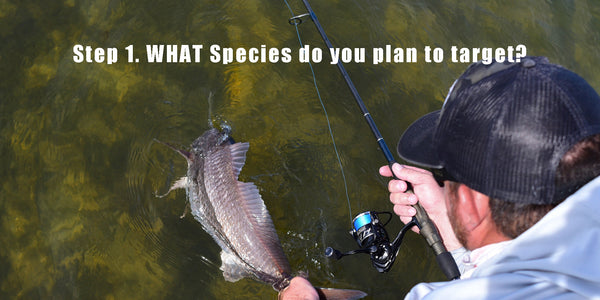Choosing the Best Saltwater Spinning Reel for You
Best Saltwater Spinning Reel for You
Looking through the reel selection at your local Bass Pro Shops can be a bit confusing, but choosing the best saltwater spinning reel for your needs is much easier than you may think.

We have created a simple 4 Step Plan to help you choose the best saltwater fishing reel for your needs OR you can scroll to the bottom of this page and watch a video of our founder breaking down how to choose the right rod & reel for your fishing needs.
Step #1: WHAT species do you plan to target?

When it comes to picking the best saltwater reel for your fishing needs, it's important to have a solid starting point. Choosing your target species is the easiest way to dial in your search for a saltwater spinning reel. Once you know what type of gamefish you plan to primarily fish for, it is much easier to dial in the best saltwater spinning reel for you.
For example: If you are intentionally targeting Sea Trout, you know that the size of the fish you are catching will average 15" to 20". With that knowledge, you should know that the saltwater spinning reel for your needs does not require a ton of torque or drag capacity. In this situation, you will probably use a 1000, 2500, or 3000 sized reel for Sea Trout. We will dial in reel size in a later step.
"But what if I intend to fish for multiple species?", you might ask. You may plan to use your saltwater fishing reel to chase after Redfish, Snook, AND Sea Trout. And that's perfectly fine as most reels can handle a variety of gamefish. However, we recommend choosing a primary gamefish species to target, which you can easily do by considering where you plan to fish in step #2.
Step #2: WHERE do you plan to target that species?

You're going to be hard pressed to find the right saltwater spinning reel for your needs if you don't know where you're fishing first. Once you dial in WHAT species you are fishing for, you will want to dial in WHERE you plan to fish for this species. And yes, it makes a big difference when choosing your desired saltwater reel.
Geography matters when it comes to fishing. Especially when you plan to use one reel for multiple species. Depending on the geographical location you are fishing, you are statistically more likely to catch one species of fish over another.
For example: You may primarily fish Pine Island Sound. Your plan is to catch Redfish, Snook, and Sea Trout on your new saltwater reel. But you know that you will primarily target Sea Trout with this specific reel. Knowing the east side of Pine Island Sound, you are FAR more likely to catch Redfish as a by-catch while Trout fishing than you are likely to catch a Snook. Given this knowledge, you can feel confident in choosing a size 2500 saltwater spinning reel for Trout fishing in Pine Island Sound.
Once you dial in where you plan to fish for your species of choice, you will want to dial HOW you plan to fish for that species.
Step #3: HOW do you plan to target that species?

When it comes to choosing the best saltwater fishing reel for you, you'll want to dial in how you plan to target your desired species. This is pretty simple. Are you going to use natural bait (live or dead) OR are you going to use artificial lures?
This may seem trivial, but it really is one of the most important steps in choosing the right saltwater spinning reel for you.
1. Natural Bait (Live or Dead)
If you plan to fish with natural bait, you DON'T need a super light-weight saltwater reel. For the most part, you (or the rod holder) is going to be holding your rod & reel and the bait is going to do the hard work of finding the fish. Generally, the lighter the reel, the more expensive it is going to cost. If you don't NEED an extremely light-weight reel, why waste the extra money?
More importantly, if you're fishing with live bait (especially under docks or mangroves), you're more likely to get hooked up and broken off on that structure than if you're fishing with artificial baits. (Think about it: dead bait sits under structure and live bait swims towards structure versus artificial lures that are retrieved alongside or away from structure.) You're generally at a disadvantage when fishing natural baits near structure, so you'll want a reel that can give you more of an advantage.
Given that knowledge, you'll want a fishing reel with a little more pulling power and torque. Generally, that is going to be a full-metal body reel with heavier duty gears. If you choose to use a light-weight reel while fishing with live bait under structure, you're far more likely to break off and lose fish.
2. Artificial Lures
If you plan to fish with artificial lures, you'll want a lighter-weight saltwater reel. During tournament fishing, we used to always say the angler who casts the most wins. While this isn't entirely true, there is a lot of truth to this statement. You CAN'T catch fish if your bait ISN'T in the water. With that being said, you want a reel that is going to maximize your time spent with a lure in the water.
A lighter-weight reel is going to cause you less fatigue and ultimately allow you to make more casts than if you are using a heavier duty reel. We generally recommend choosing a carbon or composite reel for throwing artificial lures.
Caveat: If you are fishing with LARGER lures for BIGGER gamefish around structure, I recommend using a heavier duty reel with more pulling power and torque.
Once you dial in how you plan to target your species of choice, you only have one more step before you choose the best saltwater spinning reel for you: determine the type of structure you plan to fish.
Step #4: WHAT kind of structure do you plan to fish?

You're nearing the end of the road when it comes to choosing the best saltwater spinning reel for your needs. At this point, you should know WHAT you're going to target, WHERE you plan to target that species, and HOW you plan to fish for that species. All you need to do to finish up your search for the perfect saltwater spinning reel is to determine what kind of structure you plan to fish. And yes, it makes a big difference.
Back to my earlier example: If you intend to catch Sea Trout, it makes a big difference if you are fishing for Sea Trout in open flats VS. in tight oyster lined creeks VS. on barnacle encrusted docks.
Scenario #1 - Flats: You can get away with using a size 1000 reel for trout on the flats because there isn't much you can break off on.
Scenario #2 - Creeks: You will want at least a 2500 size reel fishing for trout in creeks with oysters since there is some structure that the fish can break you off on.
Scenario #3 - Docks: You will most likely want to bump up to a 3000 size reel with a little heavier braided line and more drag capacity. When a fish pulls you around a barnacle encrusted dock, that fish is as good as gone.
Now that you have chosen WHAT species you will fish for, WHERE you plan to fish for that species, HOW you plan to catch that species, and WHAT type of structure you plan to catch that species on, you're almost ready to find out the best saltwater spinning reel for you. All you have to do is write out your answers.
For example: I want to chase Redfish in Pine Island Sound with Artificial Lures on the Flats.
Given our team's knowledge of Redfish in Pine Island Sound and the intricacies of fishing the flats with artificial lures, we would recommend an Osprey CE 2500.
Need help choosing the best saltwater spinning reel for you?
Simply send us your answer to info@floridafishingproducts.com or call us at (813)443-4045 and our team of experienced anglers will send you a saltwater reel recommendation for your specific fishing needs.
Our founder wants to help you choose the RIGHT rod & reel:

